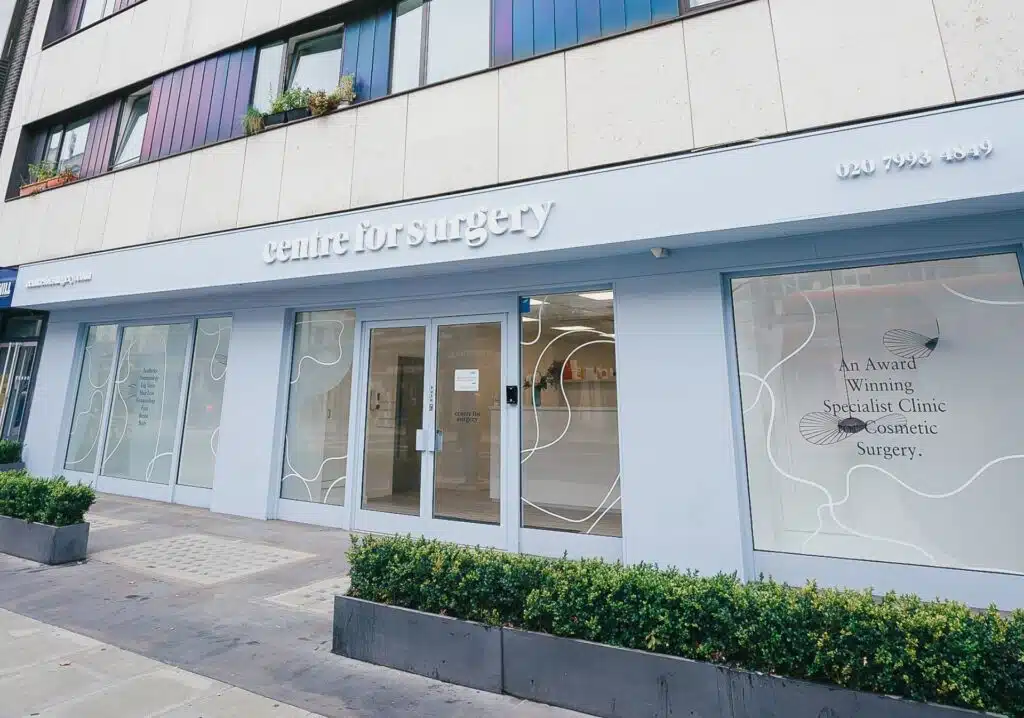Blepharoplasty is a commonly performed procedure at Centre for Surgery. Eyelid reduction is designed to make the eyelids appear more useful and refreshed. Part of the procedure’s popularity is due to the virtually invisible scarring observed, as the eyelid skin is particularly good at concealing scars within the natural skin fold of the upper eyelids. In some people with hooded eyes, the excess fold of skin may need to be surgically removed, and the incision will have to be extended laterally. Although this incision may be visible, it heals very well to leave blepharoplasty scars that are barely noticeable to others.
RELATED: What are the benefits of eyelid surgery?
Lower blepharoplasty is often carried out using a transcutaneous incision technique. The incision is well hidden just beneath the eyelashes, and the resulting lower blepharoplasty scar heals excellently. In most cases, blepharoplasty scars gradually fade over time to become virtually invisible. Any visible scarring can be easily concealed by camouflage makeup.
RELATED: Eyelid Surgery FAQs – Q&A about Blepharoplasty
How Long Do Blepharoplasty Scars Take to Heal?
Eyelid surgery, or blepharoplasty, is a procedure that many find appealing for its swift recovery times and minimal scarring. Typically, the recovery journey post-blepharoplasty is notably quick, with patients usually seeing their stitches removed within a span of seven days. Following this period, from the eighth day onwards, patients are generally given the green light to apply makeup. This is particularly beneficial as it allows for any residual redness to be effectively camouflaged, ensuring that signs of the procedure become inconspicuous.
A week after undergoing blepharoplasty, most patients find themselves healing to a degree where the signs of surgery are virtually undetectable to others. This swift progression to normalcy is a testament to the efficiency of the healing process. However, it’s worth noting that individual responses to surgery can vary. For instance, some individuals may find that their skin tends to redden post-injury or surgery. In such cases, a slight prolongation of visible redness might occur. Nonetheless, this minor aftereffect is easily managed with a concealer, allowing for any lingering traces of redness to be discreetly concealed.
Does blepharoplasty leave a permanent scar?
Whenever you undergo a surgical procedure, creating a scar is inevitable, and such scars are, by their nature, permanent. However, the visibility of these scars, especially after blepharoplasty, tends to be a concern for many. It’s reassuring to know that the skin of the eyelids is quite resilient and possesses a remarkable ability to heal so that scars can fade significantly. Over time, even if a fine line remains, it becomes so faint that detecting it without close inspection is often difficult. The advanced techniques used in eyelid surgery aim to ensure that any scarring is minimally visible, blending seamlessly with the natural contours and lines of the eyelids.
How easily do eyelids scar?
Eyelids are well-vascularised anatomical structures and, therefore, do not scar easily. Tissues with a good blood supply heal very fast compared with other body areas, such as the lower legs, which often take a longer period to heal. As with any type of surgery, all incisions will result in the formation of a scar, although eyelid scars are barely noticeable after six months as they fade to a pale white colour.
RELATED: What Causes Lumps After Blepharoplasty?
Can blepharoplasty produce eyelid scars that are well hidden?
The ability to hide eyelid scars after blepharoplasty surgery depends on the skill and expertise of your surgeon. Centre for Surgery is home to some of the most experienced consultant plastic surgeons in the UK. They are fully trained in all aspects of eyelid reduction surgery. They can position incisions so that any resulting blepharoplasty scars are placed within the natural folds of the upper eyelids. Lower eyelid surgery involves expert placement of incisions just beneath the eyelash line, which are virtually invisible once full blepharoplasty recovery has occurred.
How long do blepharoplasty scars take to fade?
Blepharoplasty recovery takes approximately 6 to 8 weeks, although it can take longer for the scars to fade. It is usual for them to take anywhere between 6 to 12 months.
How do you hide scars from eyelid surgery?
The strategic placement of incisions is key to concealing scars from eyelid surgery effectively. For the upper eyelids, the incision is typically made within the natural crease, extending just slightly beyond the outer edge of the eye. This approach removes excess skin while ensuring the scar remains hidden when the eyes are open, making it virtually invisible during everyday interactions and activities. In the case of lower eyelids, incisions are made with precision either just inside the lash line, leaving no visible external scar, or directly beneath the eyelashes. This placement allows the scar to blend into the natural crease that many people have, further camouflaging its presence.
What is the best way to prevent scarring after blepharoplasty?
Thanks to its rich blood supply, the skin of the eyelids heals remarkably quickly and with the formation of excellent scars in the vast majority of cases. Many people notice that, as early as six months after eyelid surgery, their scars are virtually invisible. We recommend certain methods to improve the appearance of scars after blepharoplasty. Silicone gel sheets are a clinically effective method to flatten eyelid scars. In the first four weeks after eyelid reduction, you should refrain from applying any topical skin care products to the eyelids as this may interfere with healing. Please speak to a member of our postoperative nursing team for advice on ideal topical products to use on your eyelids during the healing period.
Complying fully with all of your surgeon’s post-operative care instructions is the best way to minimise scarring and optimise healing. Doing so will help minimise the risk of complications after blepharoplasty surgery.
How long will my eyes be swollen after blepharoplasty?
Ice packs can be applied against the eyelids for the first few days after surgery to help reduce bruising and swelling. This should be combined with lying in an elevated position to accelerate the resolution of bruising. You should avoid getting the area wet for the first seven days after surgery, including avoiding showering. Strenuous exercise, including going to the gym and sexual intercourse, should be avoided until your surgeon has assessed you. It is essential to protect your healing blepharoplasty scars from direct sunlight exposure. Wearing sunglasses will help prevent your eyelid scars from developing excessive scarring. You should also avoid smoking, and smoking has been linked to delayed healing and an increased risk of wound complications after blepharoplasty. You should also avoid wearing contact lenses as these can irritate the incisions. Similarly, habitual rubbing off your eyes should be avoided as this can traumatise the delicate healing incisions, which could potentially lead to wound breakdown and the risk of prominent scarring.
RELATED: How to Reduce Bruising and Swelling after Eyelid Surgery
Blepharoplasty at Centre for Surgery
Centre for Surgery is home to the leading consultant plastic surgeons in London and they work closely with our expert aesthetic practitioners who have access to the full range of scar management techniques including laser scar reduction. If you would like to learn more about blepharoplasty surgery and ways to reduce the appearance of blepharoplasty scars, please get in touch with us today at 020 7993 4849 or complete the contact form below to start your patient journey today at our state-of-the-art cosmetic surgery clinic in Marylebone.










